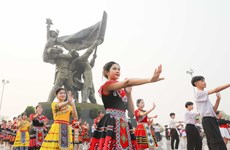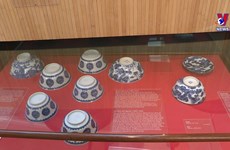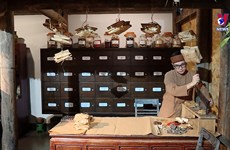Trang An seeks world natural heritage status
As many as 300 delegates to the UNESCO World Congress, ambassadors from
30 countries and territories, and guests on Aug. 21 visited the
ecotourism region of Trang An, ancient citadel of Hoa Lu and Bai Dinh
temple in Ninh Binh province.
As many as 300 delegates to the UNESCO World Congress, ambassadors from
30 countries and territories, and guests on Aug. 21 visited the
ecotourism region of Trang An, ancient citadel of Hoa Lu and Bai Dinh
temple in Ninh Binh province.
The trip was expected to seek support from the delegates and world UNESCO members for the recognition of Trang An as a world natural heritage site.
After the visit, President of the World Federation of UNESCO Clubs, Centres and Associations George Christophides praised the imposing scenery in Ninh Binh and promised to shares his experience of the trip with families and friends across continents.
With a total area of 2,168 ha, surrounded by limestone mountains, lakes and caves, Trang An is constantly referred as “Ha Long Bay on land” and “an outdoor geological museum”. There are 500 different plants, 73 species of birds, 41 species of animals and 31 reptile species within the site. The stripe-neck musk turtle, which is considered to be rare and in need of protection, is also a resident here.
In addition, ancient relics of prehistoric man, from 5,000 to 30,000 years ago, were found in caves such as cave Bui and cave Trong. Historic monuments such as the temples of King Dinh Tien Hoang and King Le Dai Hanh, Dong and Den bridges and traces of the citadel ancient walls are still preserved, maintaining the legendary feeling of Hoa Lu.
Chairman of the Ninh Binh People’s Committee Bui Van Thang affirmed that the province would focus more on preserving, restoring and exploiting natural resources in the province, in order to attract tourists and develop the province’s economy.
At the Bai Dinh temple, the delegates took part in a Buddhist ceremony, praying for world peace./.
The trip was expected to seek support from the delegates and world UNESCO members for the recognition of Trang An as a world natural heritage site.
After the visit, President of the World Federation of UNESCO Clubs, Centres and Associations George Christophides praised the imposing scenery in Ninh Binh and promised to shares his experience of the trip with families and friends across continents.
With a total area of 2,168 ha, surrounded by limestone mountains, lakes and caves, Trang An is constantly referred as “Ha Long Bay on land” and “an outdoor geological museum”. There are 500 different plants, 73 species of birds, 41 species of animals and 31 reptile species within the site. The stripe-neck musk turtle, which is considered to be rare and in need of protection, is also a resident here.
In addition, ancient relics of prehistoric man, from 5,000 to 30,000 years ago, were found in caves such as cave Bui and cave Trong. Historic monuments such as the temples of King Dinh Tien Hoang and King Le Dai Hanh, Dong and Den bridges and traces of the citadel ancient walls are still preserved, maintaining the legendary feeling of Hoa Lu.
Chairman of the Ninh Binh People’s Committee Bui Van Thang affirmed that the province would focus more on preserving, restoring and exploiting natural resources in the province, in order to attract tourists and develop the province’s economy.
At the Bai Dinh temple, the delegates took part in a Buddhist ceremony, praying for world peace./.












